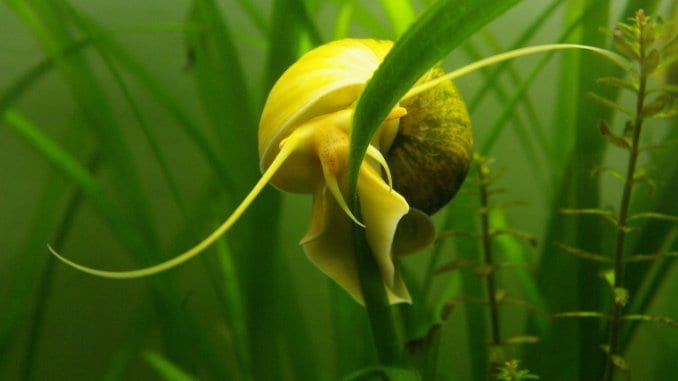
There are lots of popular questions about snails, including how long do snails sleep and what do you feed a snail?
Today, we are going to focus on what do snails eat.
There are many different types of snails that you can keep in an aquarium or outdoor garden pond. These snails all have different diets based upon the type of food that they would find in their natural habitats.
If you want to know what to feed your snail, you must first get to know your snail.
This article will explain what snails eat and the best way to feed them in your aquarium.
TABLE OF CONTENTS
What Do Snails Eat In The Wild?
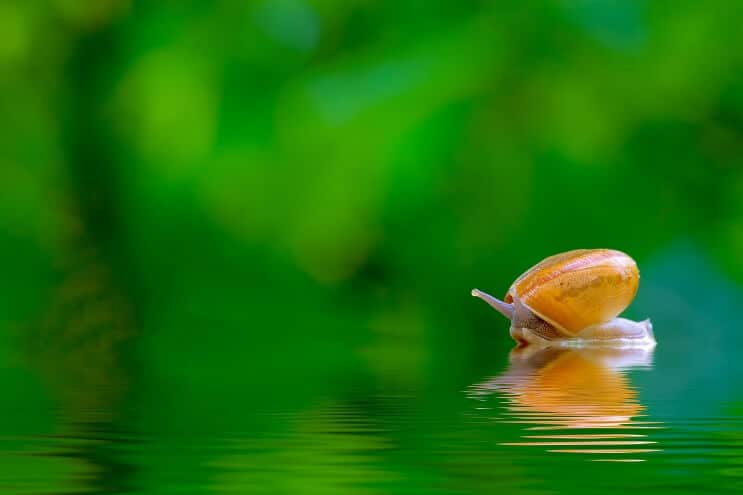
Snails and slugs are gastropods, belonging to the phylum Mollusca. They come in all different shapes, colors, and sizes, but they all share the common feature of having a shell and a foot which they use to move around.
They feed using a tongue-like organ called a radula. Their radula has thousands of tiny microscopic teeth which snails use to scrape up plant material and eat prey.
Snails with different dietary requirements use their radulae in different ways to feed on a variety of food types.
Garden snails usually come out to eat at night and on rainy or overcast days. They enjoy moisture and are a common sight after rainfall.
Most garden snails eat vegetation and are known pests in gardens and crop farms. They love seedlings and thick-leaved plants, along with fruits and vegetables. They will eat tree bark and flowers as well.
Snails will also eat dead plants or animal material. This makes them effective decomposers in natural food cycles.
Like land snails, many aquatic snails also enjoy vegetation. They will eat submerged and floating plants that grow in lakes, rivers, and ponds.
In aquatic environments, snails will graze on algae that grow over rocks and sediment. They will use their radulae to scrape it up.
Carnivorous aquarium snails will eat live prey such as worms, insects, and small crustaceans. They may even eat other snails.
What Do Sea Snails Eat?
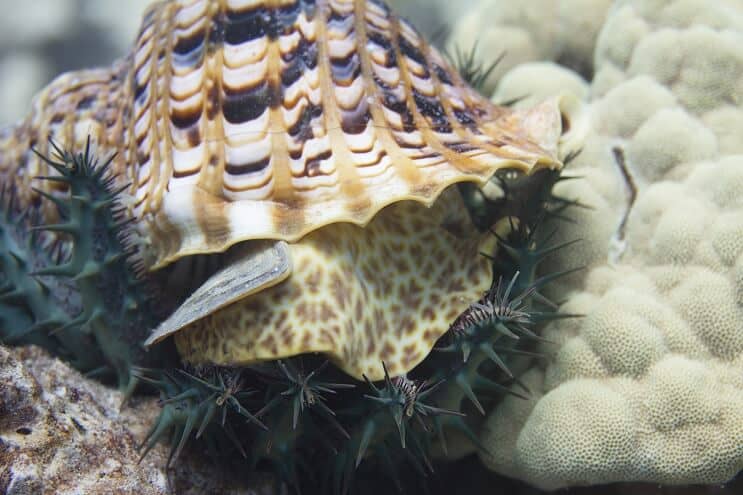
Sea snails include limpets, abalones, and cone snails. They often have attractive shells that many people like to collect from the beach.
These snails get the calcium they need to keep their shells strong by eating the shells of other marine animals, including other snails.
Most sea snails are algal grazers and will eat the algae that form over rocks, sediment, and reefs.
Grazing on algae also helps keep the snail’s habitat clean. Algal-grazing sea snails include abalones, limpets, and cowries.
Other sea snails eat dead plant and animal matter, or can even be predatory. Predatory sea snails like tritons, whelks, and cone snails eat other invertebrates. Tritons are one of the few predators of the crown-of-thorns starfish, a dangerous predator to coral reefs.
The oyster drill is a snail that preys on oyster reefs, using its radula to bore holes through the oyster’s shell.
Other predatory sea snails eat mussels, clams, and other snails. Moon snails will even eat each other!
Some carnivorous sea snails can carry powerful venom in their radulas, used to kill or incapacitate their prey. The venom of a cone snail is deadly even to humans.
In an aquarium, the best foods for feeding a sea snail are:
- Algae
- Alginate and algae tablets
- Crushed shells
- Calcium supplements
- Live clams (carnivorous snails)
- Brine shrimp (carnivorous snails)
- Feeder snails (carnivorous snails)
- Slow-sinking fish foods
What Do Freshwater (Aquarium) Snails Eat?
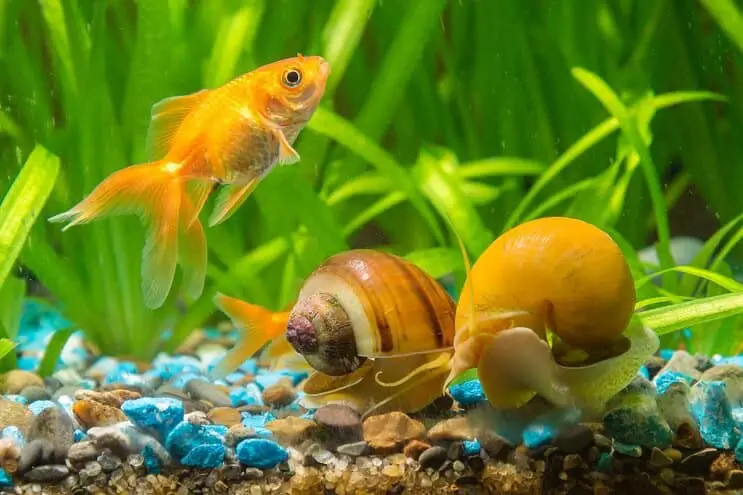
Most common aquarium snails are freshwater snails – this include nerites, mystery snails, and apple snails.
Like sea snails, most freshwater snails are grazers. They are algae eaters, and also eat detritus and bacteria that form on rocks and the substrate.
Many love to eat plants and are considered pests to crops and submerged aquatic vegetation. Other snails use their mucus to trap and filter particles from the water column. Very few of them are carnivorous.
In your aquarium, your snails should be given a continuous supply of natural algae and plant life. In a well-stocked tank, your snails will feed themselves!
Snails also love garden vegetables. You can feed them lettuce, kale, cucumbers, and zucchini that are washed and lightly blanched.
For a little extra protein and calcium, choose a tablet or pellet food that sinks slowly and can reach the bottom without being gobbled up by your snails’ tank mates. If your tank doesn’t have lots of algae, you may need to provide alginate or a supplemental algae tablet.
You might find that your snails will eat up their tank mates’ leftovers as well.
Carnivorous snails like assassin snails must be given live prey, including bloodworms and small shrimp.
Feeding time depends on the type of food that is being offered. For vegetables, a continuous supply provides the best health benefits for your snails.
If you keep your tank well-stocked with plants and algae, your snails will find food on their own and will not need to be fed much extra. Tablets and alginate are better as supplements, and only need to be given once a day (or even less in an algae-dense tank).
Carnivorous snails should be fed a steady supply of live prey once/twice a day.
The best foods for freshwater aquarium snails are:
- Raw or cooked lettuce
- Raw or cooked kale
- Raw or cooked, blanched cucumber
- Raw or cooked, blanched zucchini
- Submerged vegetation; water hyacinth anacharis, water lettuce, floating weeds
- Natural-forming macroalgae
- Benthic microalgae and cyanobacteria
- Algae tablets and alginate
- Slow-sinking fish pellets
- Commercial snail mixes
- Bloodworms (carnivorous snails)
- Brine shrimp (carnivorous snails)
- Feeder snails (carnivorous snails)
What Do Pond Snails Eat?
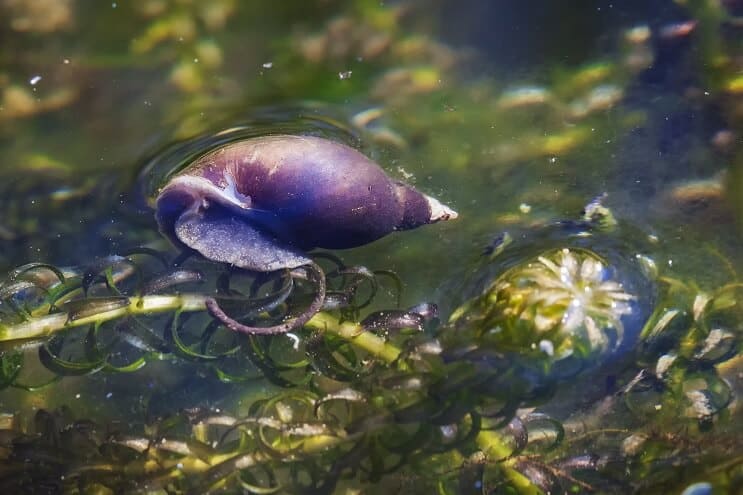
The diet of pond snails is not too different from the diets of freshwater snails.
They will eat algae, plants, and suspended particles in the water column. Just like in an aquarium, snails will feed themselves in a pond well stocked with vegetation and algae.
Some good plant choices for your pond snails include water hyacinth, water lettuce, bladderworts, duckweeds, and anacharis. Anacharis encourages the growth of algal colonies that snails crave, making it a very good choice for any snail pond.
Pond snails will eat garden vegetables but prefer more natural vegetation. Consider growing a snail-friendly vegetable garden right alongside your pond, and offer cooked vegetables only as a supplement.
Carnivorous pond snails will eat insects and insect larvae, worms, and other snails.
You do not need to provide extra food for your pond snails if your pond is vegetation-heavy. Just make sure that your plants are well-tended and any dead or decaying plants are replaced.
Carnivorous snails will go after the live prey that is naturally attracted to your pond. They can be great pest control for gardens.
In higher temperatures, your pond snails will need to eat more. You can provide outside foods and algal pellets or tablets at least once a day during the summer months. In lower temperatures, feeding will decrease as the snails prepare for dormancy.
The best foods for pond snails are:
- Lettuce, Cucumbers, Zucchini, Kale
- Berries and berry leaves
- Aquatic freshwater plants: anacharis, floating weeds, water hyacinth
- Naturally-forming macroalgae
- Benthic microalgae and cyanobacteria
- Large-leaf foliage
- Terrestrial flowers
- Bloodworms (carnivorous snails)
- Brine shrimp (carnivorous snails)
- Feeder snails (carnivorous snails)
- Water fleas (carnivorous snails)
FAQs on What Do Snails Eat
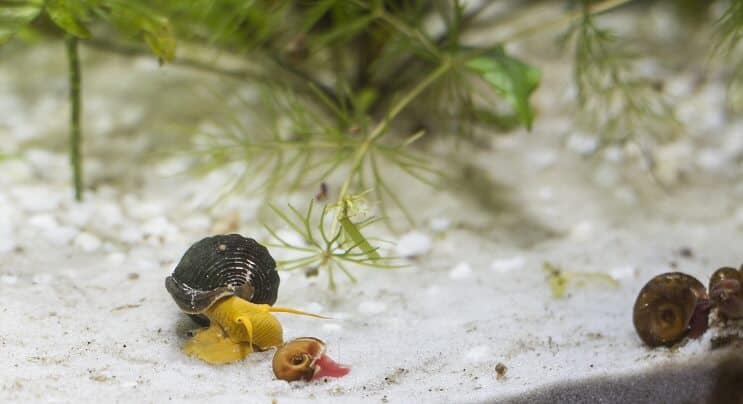
What Do Nerite Snails Eat?
Nerite snails are some of the very best algae cleaners around.
These guys love to graze on the algae that form on the surface of your tank. They will also eat cooked vegetables like lettuce and zucchini.
They can be marine or freshwater, and some may specialize in eating only one or two kinds of algae.
Since these snails prefer algae, they will not damage any plants you include as part of your aquascape.
What Do Apple Snails Eat?
Apple snails just love aquatic plants.
These snails have very big appetites, and they are considered a pest to water-growing crops like rice and taro.
They will eat living or dead plant matter and also feed on algae and microbe colonies.
Though they are native to South America, they have become invasive in some US states and Asian countries due to their popularity in the aquarium trade.
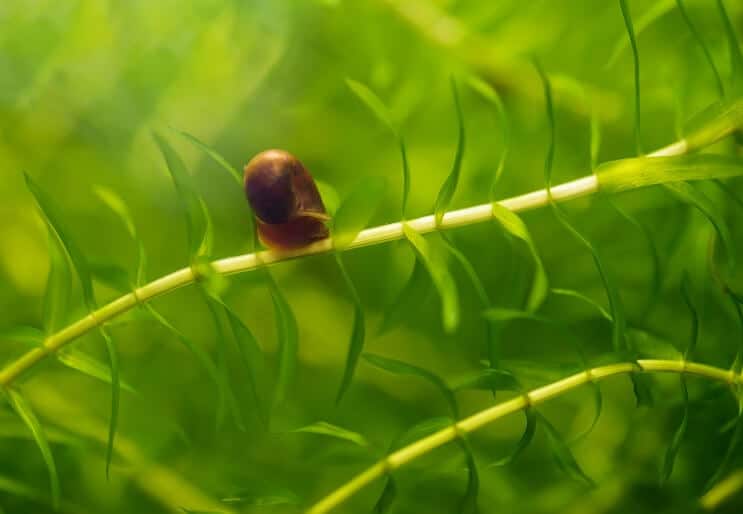
What Do Mystery Snails Eat?
Like nerite snails, mystery snails are very effective algae cleaners. They will eat surface and benthic algae and can be given alginate and algae tablets as a supplement.
They will not damage your aquarium plants. They also eat detritus and animal carrion if it is available, making them good decomposers and nutrient cyclers.
What Do Baby Snails Eat?
Newly hatched snail larvae will feed on microscopic algae and bacteria in the water column.
Once they develop their shells and settle on the substrate, they will eat the same algae, plants, and detritus that the adults do.
Baby snails need to be fed more often than adult snails. They do very well on cooked lettuce and kale and should be fed twice a day while they are still growing.
Juvenile snails are still developing their shells, so it is important that they have a source of calcium for shell health and strength.
You can give them crushed eggshells, clamshells, or snail shells alongside their regular food.
Summary
Snails don’t ask for much. Feeding and caring for them is simple, and in many cases, it’s almost completely hands-off.
If you know the right kind of food for your particular snail, you can keep your tank stocked and the snail will feed itself.
After reading this article you should know what snails eat in the wild and in aquariums.
Snails might not be the most active or amusing, but if you take good care of them, they make a great tank clean up crew.
Do you have any questions about what snails eat? Let us know in the comments section below…

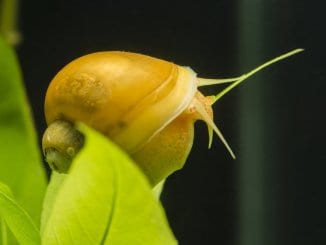
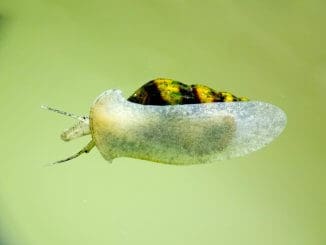
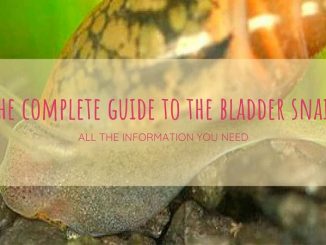
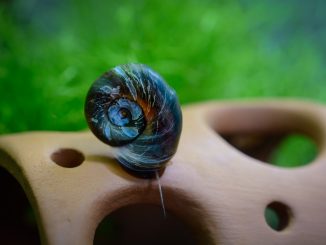
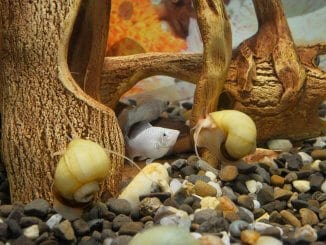
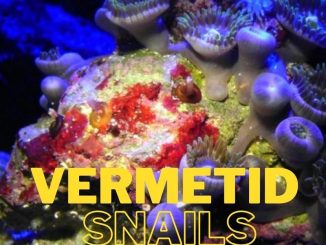
Be the first to comment